Table 1.
Inhibitors and stimulators of HR proteins
| Small molecule compound | Target protein | Mechanism | Potency (EC50) in vitro | Specificity in vitro | Cellular effect |
|---|---|---|---|---|---|

|
RAD51 | Inhibits RAD51 binding to ssDNA | 1–2 μM | N/A | N/A |
|
Metatungstate (Na6H2W12O40) 2 |
MvRadA | Inhibits MvRadA binding to ssDNA and dsDNA | ~2.5 μM | N/A | N/A |
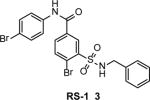
|
RAD51 | Stabilizes the RAD51-ssDNA filament | N/A | Yes | Induces resistance of human fibroblasts to cisplatin. |
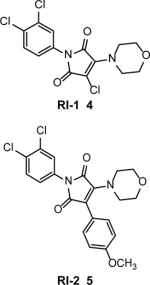
|
RAD51 | Disrupts RAD51 oligomerization |
4:5–30 μM/(0.2–0.4 μM RAD51) 5 : 44 μM/(0.2–0.4 μM RAD51) |
Yes yes |
Sensitizes human cancer cells to mitomycin C |
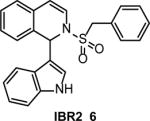
|
RAD51 | Disrupts RAD51 binding to BRCA2 and RAD51 oligomerization | N/A | yes | Inhibits of HR in human cells; increases the sensitivity of MCF7 to IR. |
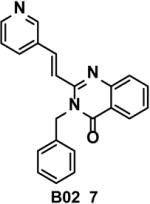
|
RAD51 | Disrupts RAD51 binding to DNA | 27μM/1μM RAD51 | yes | Increases cell sensitivity to cisplatin and mitomycin C |

|
RAD54 | Binds to RAD54 and inactivates its ATPase by generating reactive oxygen species | 16.5μM/(0.1μM RAD54) | yes | N/A |
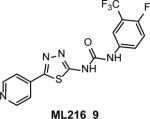
|
BLM | Disrupts BLM binding to DNA | Helicase activity: 3μM/10nM; BM activity:50μM/10nM |
No (also inhibits WRN in vitro) | Enhances the toxicity of aphidicolin and exerts antiproliferative effect in cells expressing BLM. |
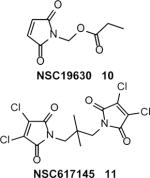
|
WRN | Inhibits the helicase activity with a milder inhibition of the ATPase and exonuclease activity | 10: 20 μM/1.2nM; 11:N/A | Yes | NSC617145 causes sensitization of FA and NHEJ-deficient cells to mitomycin C |
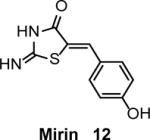
|
MRN | Inhibits Mre11 exonuclease activity and prevents MRN-dependent activation of ATM | 12 μM | yes | Inhibits HR-mediated DNA repair in HEK293 cells |
Note: MvRadA = Methanococcus voltae RadA
